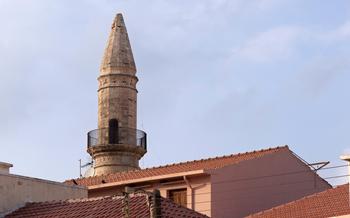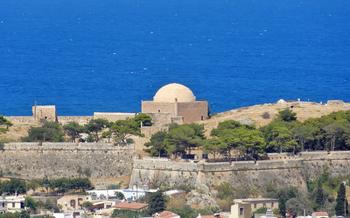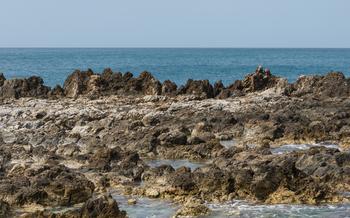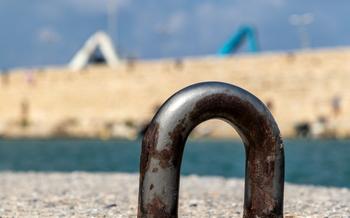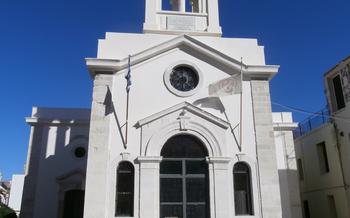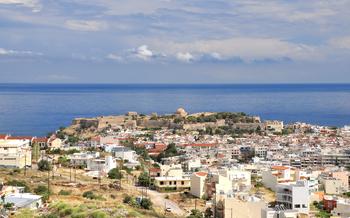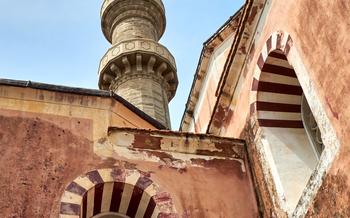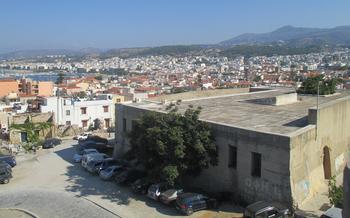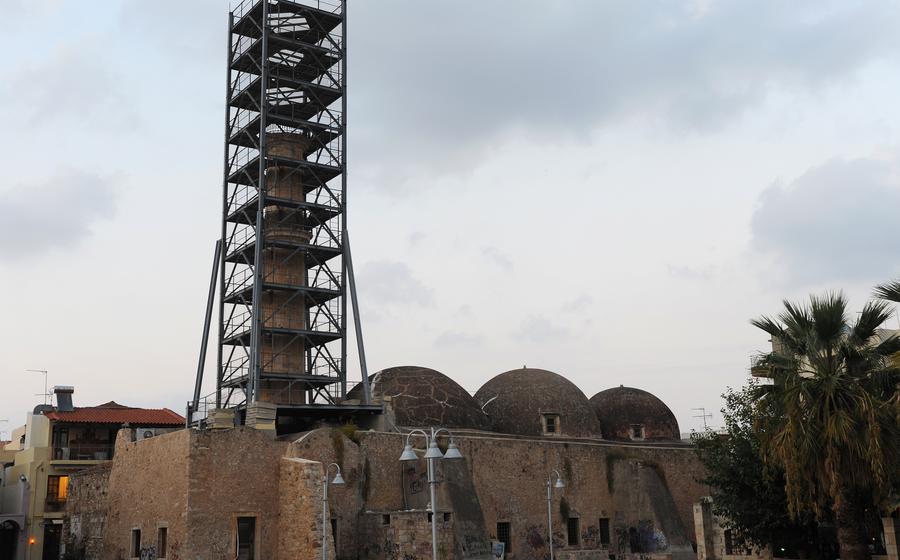
Neratze Mosque and Minaret
- Neratze Mosque: A Stunning Legacy of Ottoman Architecture
- The Minaret: A Symbol of Faith and Resilience
- Exploring the Interior: A Journey into History
- Unveiling the History: The Neratze Mosque Through the Ages
- The Cultural Tapestry of Rethymno: A City of Diverse Influences
- Tips for Visiting the Neratze Mosque and Minaret
- Immerse Yourself in the Atmosphere: A Sensory Experience
- Capture the Essence: Photography and Memories
- Local Insights: Engaging with the Community
- Historical Significance: A Witness to the Past
- Architectural Masterpiece: A Blend of Styles
- Symbol of Tolerance: A Shared Heritage
- Preservation and Restoration: Ensuring the Legacy
- Local Traditions: Unveiling the City's Soul
Neratze Mosque: A Stunning Legacy of Ottoman Architecture
In the vibrant city of Rethymno, a captivating legacy of the past unfolds within the walls of the Neratze Mosque, a testament to the city's diverse cultural heritage. Erected during the Ottoman period in the 17th century, this architectural gem stands as a symbol of Rethymno's rich past, where East meets West in a harmonious blend of Islamic and Venetian styles.
The mosque's intricate stone carvings, delicate arches, and vibrant tiles showcase the skill and artistry of its builders. Its imposing minaret, a symbol of faith and resilience, pierces the sky, serving as a navigational landmark for sailors and a beacon of hope for the faithful. Step inside the mosque's prayer hall, and be transported to a realm of tranquility and devotion. The intricate Islamic designs and decorative elements create an atmosphere of serenity, inviting visitors to reflect and appreciate the mosque's spiritual significance.
The Minaret: A Symbol of Faith and Resilience
The minaret of the Neratze Mosque stands tall and proud, a testament to the faith and resilience of the Muslim community in Rethymno. Built as an integral part of the mosque, the minaret served as a vital element in Islamic architecture, facilitating the call to prayer and symbolizing the presence of God. Its design and construction reflect the rich craftsmanship and attention to detail that characterized Islamic architecture during the Ottoman period.
The minaret's slender form, topped with a delicate crescent, is a familiar landmark in the Rethymno skyline. Its height allowed the muezzin's call to prayer to reach far and wide, summoning the faithful to prayer five times a day. The minaret also served as a navigational aid for sailors and travelers, guiding them towards the city's harbor.
Today, the minaret remains a prominent feature of the Neratze Mosque, a reminder of its historical and religious significance. Its presence speaks to the enduring legacy of the Ottoman Empire in Rethymno and the city's rich cultural heritage.
Exploring the Interior: A Journey into History
Stepping inside the Neratze Mosque is like embarking on a journey through time. The prayer hall, with its intricate Islamic designs and decorative elements, transports visitors to a bygone era. The mihrab, indicating the direction of Mecca, serves as a focal point for prayer and adds to the mosque's spiritual atmosphere. The minbar, a raised platform used by the imam to deliver sermons and religious teachings, stands as a testament to the mosque's role as a center of Islamic learning and guidance. The overall ambiance within the mosque is one of tranquility and peace, inviting visitors to reflect on the mosque's historical and religious significance.
Unveiling the History: The Neratze Mosque Through the Ages
In the 17th century, under the rule of the Ottoman Empire, the Neratze Mosque was constructed, embodying the city's rich multicultural heritage. Its architectural style reflected a harmonious blend of Islamic and Venetian influences, showcasing the diverse cultural influences that shaped Rethymno. During the Venetian period, the mosque underwent a transformation, becoming a church, a testament to the city's religious diversity. In the present day, the mosque has been meticulously restored and reopened to the public, standing as a significant historical and cultural landmark. Ongoing efforts to preserve and promote its heritage ensure that the Neratze Mosque continues to captivate visitors and serve as a symbol of Rethymno's enduring legacy.
The Cultural Tapestry of Rethymno: A City of Diverse Influences
Rethymno's strategic location as a crossroads of civilizations has resulted in a rich blend of cultures that has shaped its unique identity. The city's architecture, cuisine, and traditions bear witness to the influence of Venetian, Ottoman, and Greek cultures, creating a vibrant tapestry of diversity. Throughout history, Rethymno has been home to various religious communities that have peacefully coexisted, contributing to the city's harmonious atmosphere. This cultural diversity is further reflected in the city's vibrant cultural scene, where visitors can experience festivals, events, and local customs that showcase Rethymno's rich heritage.
Tips for Visiting the Neratze Mosque and Minaret
When visiting the Neratze Mosque, it is important to be respectful of the fact that it is an active place of worship. Visitors should dress modestly and avoid wearing shorts, tank tops, or other revealing clothing. It is also important to be quiet and refrain from talking or laughing loudly. Visitors should also be mindful of prayer times and avoid disturbing worshippers during these periods. The mosque is open to the public during certain hours, so it is advisable to check the visiting schedule in advance. Visitors can enhance their experience by learning about Islamic customs and traditions before visiting the mosque.
Immerse Yourself in the Atmosphere: A Sensory Experience
As you step inside the Neratze Mosque, a sense of serenity washes over you. The tranquil atmosphere invites you to find peace and tranquility within its walls. Your eyes are drawn to the intricate details and craftsmanship of the mosque's architecture, a visual feast that showcases the skill of its builders. The melodic sounds of the muezzin's call to prayer create a unique auditory experience, transporting you to a different time and place. The scent of incense and the gentle flutter of prayer rugs add to the mosque's sensory allure, creating an immersive and spiritual experience that will stay with you long after your visit.
Capture the Essence: Photography and Memories
The Neratze Mosque and Minaret offer a picturesque backdrop for capturing stunning photographs. Visitors can immortalize their visit by taking pictures of the mosque's intricate exterior, its serene courtyard, and its beautifully decorated interior. However, it is important to be respectful of the mosque's religious significance and avoid taking intrusive or disrespectful photos, especially during prayer times. The mosque's unique ambiance and atmosphere make it an ideal setting for creating lasting memories. Sharing these photos and experiences on social media can help promote the mosque's cultural and historical significance, encouraging others to explore this hidden gem of Rethymno.
Local Insights: Engaging with the Community
To truly immerse yourself in the cultural tapestry of Rethymno, engage with the local residents and guides who hold a wealth of knowledge about the Neratze Mosque and its significance. Strike up conversations with shopkeepers, artisans, and friendly locals to gain insights into the city's past and present. Attend local festivals and events to witness the vibrant traditions and customs that have been passed down through generations. By embracing the local culture and interacting with its people, you will gain a deeper understanding of Rethymno's unique identity and the role the mosque has played in shaping its rich history. Remember to approach interactions with respect and curiosity, and you will be rewarded with a more authentic and memorable experience.
Historical Significance: A Witness to the Past
The Neratze Mosque stands as a testament to Rethymno's rich and complex history, spanning different civilizations and cultures. Its construction in the 17th century under Ottoman rule reflects the city's multicultural heritage, where diverse influences shaped its architectural and cultural landscape. The mosque's survival through various historical events, including wars and regime changes, speaks to its resilience and enduring importance. Its transformation into a church during the Venetian period and its subsequent restoration and reopening as a place of worship demonstrate Rethymno's commitment to preserving its cultural heritage. Visitors to the Neratze Mosque can appreciate its historical significance by learning about its past and its impact on the city, gaining a deeper understanding of Rethymno's unique identity and its contributions to the region's rich history.
Architectural Masterpiece: A Blend of Styles
The Neratze Mosque stands as a testament to the architectural prowess of its builders, showcasing a harmonious blend of Islamic, Venetian, and Byzantine influences. Its intricate stone carvings, delicate arches, and colorful tiles are a feast for the eyes, demonstrating the skill and artistry of the craftsmen who created this masterpiece.
The mosque's exterior features intricate geometric patterns and decorative motifs, inspired by Islamic architectural traditions. The graceful minaret, with its spiraling staircase and elegant proportions, adds a touch of grandeur to the overall design. Inside the mosque, visitors are greeted by a spacious prayer hall adorned with elegant arches, intricate mihrab, and a beautifully carved minbar.
The Neratze Mosque's architectural significance lies in its unique fusion of styles, reflecting the diverse cultural influences that have shaped Rethymno's history. This architectural masterpiece serves as a reminder of the city's rich past and its enduring legacy as a crossroads of civilizations.
Symbol of Tolerance: A Shared Heritage
The Neratze Mosque stands as a testament to Rethymno's remarkable history of religious tolerance and coexistence. During the Venetian period, the mosque was transformed into a church, demonstrating the city's ability to adapt and embrace diversity. This transformation reflects the harmonious relationship between different religious communities in Rethymno throughout the centuries. Today, the mosque's restoration and reopening as a place of worship further underscores the city's commitment to preserving its rich cultural heritage. Visitors to the mosque can appreciate its significance as a symbol of tolerance and learn from its history, which exemplifies the power of understanding and cooperation among different faiths.
Preservation and Restoration: Ensuring the Legacy
The Neratze Mosque has undergone extensive preservation and restoration efforts to ensure its continued existence for future generations. Recognizing its historical and cultural significance, the local authorities and heritage organizations have collaborated to restore the mosque to its former glory while maintaining its original features. The restoration process involved meticulous attention to detail, using traditional techniques and materials to preserve the mosque's authenticity. This delicate work required careful planning and coordination to address the challenges posed by time, environmental factors, and the need to balance restoration with preservation. The successful restoration of the Neratze Mosque serves as a testament to the commitment to preserving cultural heritage sites and ensuring that this architectural gem continues to stand as a symbol of Rethymno's rich history.
Local Traditions: Unveiling the City's Soul
Beyond the Neratze Mosque, Rethymno is a treasure trove of local traditions and customs that reflect its rich cultural heritage. Visitors can immerse themselves in the city's vibrant festivals and events, which showcase traditional music, dance, and cuisine. The annual Rethymno Carnival, held before Lent, is a riot of color and revelry, with elaborate costumes, parades, and street parties.
Local artisans and craftsmen keep alive traditional crafts and techniques, creating exquisite handmade pottery, textiles, and jewelry. Visitors can explore the workshops of these artisans and learn about their skills and processes. The city's cuisine is a delicious blend of Greek, Venetian, and Ottoman influences, with dishes such as dakos (a Cretan salad with barley rusks), bourbourela (fried zucchini balls), and staka (a creamy cheese made from sheep's milk) being local favorites.
